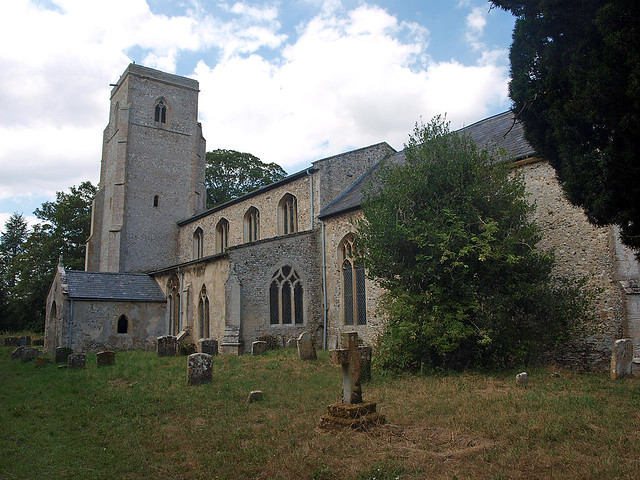ST PETER. Tall SW tower; Dec, including the E arch into the aisle.* Dec arcades of four bays. Octagonal piers and double-chamfered arches. Dec some windows too (N aisle W; S aisle), but most of them Perp. Late Perp clerestory and uncommonly fine roof. Low pitch, alternating tie-beams and hammer-beams, the latter with carved figures. - BENCH ENDS. A few, with poppy-heads. - PLATE. Chalice, Paten, and Flagon, 1681, the Chalice and Paten remade from 1568 plate. - MONUMENTS. John Hungerford, 1719, signed by R. Singleton. Badly carved. With two busts and above them a still-life of musical instruments. Columns l. and r., putti standing outside them. - Cyril Wyche d. 1780. By John Ivory and J. de Carle. With crying putti by a broken column. Urn on top.
* The Rev. D. F. Page writes: 'The fluted bases are probably Saxon.'
HOCKWOLD-CUM-WILTON. The two places run from one to the other, both with
many flint-walled cottages, and each with an old church.
Wilton has a slender cross on the green near the church of St James, which comes from the 14th and 15th centuries. Its old porch keeps its old oak roof, and lovely rafters look down on the cream-walled nave and chancel, full of light. The great chancel arch reaches the roof. There are quaint niches in the splays of two windows, and under one is a trefoiled piscina. The tapering font is old, and there are old glass fragments. The chief charm of the church is in its woodwork, from the roofs down to the oak chest. There is a fine array of richly carved benches, and among their carvings, old and new, are quaint grotesques, a shepherd with sheep, an old woman who seems to be talking to a headless companion, and a man on all fours. There is delicate tracery in the old screen, one side of which has a curious scene of a cross-legged man wearing a crown and two jesters on galloping horses by his side.
Hockwold’s church of St Peter keeps company with Hockwold Hall by the wayside. The house has walls of mellowed brick, gables, and clustered chimneys, and has a story centuries old. The church is 14th and 15th century, with a great array of old windows. The chancel has fine old seats for the priests and in the nave is a patch of ancient wall painting strewn with daisies. Fiddles and flutes, trumpets and cherubs, adorn an 18th-century wall monument to John Hungerford and his wife. The glory of the church is the beautiful nave roof, its carved tie-beams alternating with hammerbeams, from which eight figures of saints look down, their hands upraised and some of them wearing crowns.
Wilton has a slender cross on the green near the church of St James, which comes from the 14th and 15th centuries. Its old porch keeps its old oak roof, and lovely rafters look down on the cream-walled nave and chancel, full of light. The great chancel arch reaches the roof. There are quaint niches in the splays of two windows, and under one is a trefoiled piscina. The tapering font is old, and there are old glass fragments. The chief charm of the church is in its woodwork, from the roofs down to the oak chest. There is a fine array of richly carved benches, and among their carvings, old and new, are quaint grotesques, a shepherd with sheep, an old woman who seems to be talking to a headless companion, and a man on all fours. There is delicate tracery in the old screen, one side of which has a curious scene of a cross-legged man wearing a crown and two jesters on galloping horses by his side.
Hockwold’s church of St Peter keeps company with Hockwold Hall by the wayside. The house has walls of mellowed brick, gables, and clustered chimneys, and has a story centuries old. The church is 14th and 15th century, with a great array of old windows. The chancel has fine old seats for the priests and in the nave is a patch of ancient wall painting strewn with daisies. Fiddles and flutes, trumpets and cherubs, adorn an 18th-century wall monument to John Hungerford and his wife. The glory of the church is the beautiful nave roof, its carved tie-beams alternating with hammerbeams, from which eight figures of saints look down, their hands upraised and some of them wearing crowns.

No comments:
Post a Comment